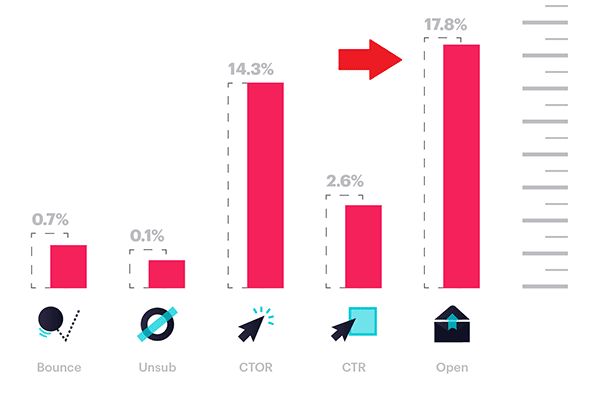Disclaimer:
While this post discusses key aspects of email marketing, please note that War Room does not offer email marketing services. However, we believe in a holistic digital approach, where various tactics like paid, social, SEO work together to complement your overall marketing strategy. Our focus is on programmatic advertising, using data-driven strategies to optimize paid media campaigns. If you’re looking to boost your ad performance, we’re here to help!
When people talk about email marketing, they mention the most common mistakes to avoid or bring successful examples to follow in the first place.
While email marketing metrics unreasonably shift to the second clasp. No matter how optimized and fancy your email marketing campaigns are, if you can’t see how they help you achieve your goals, all those efforts will be for nothing.
So, before sending your next letter, stop for a moment and ask yourself: what do I want it to achieve? Once you have defined your target, you can figure out email marketing metrics you will need to track to stay within the chosen path.
Email Marketing Analytics Defined
Email marketing analytics is the set of practices that help plan all your actions, including projections for upcoming campaigns. It combines marketing data testing, mapping, and interpreting to determine which parts of email marketing campaigns work, which don’t, and which should be improved.
What are the best KPIs for email marketing analytics? At first glance, one could improve conversions and stop there. While it could work, email marketing analytics will rock only with an in-depth look at your email marketing efforts. This is where analysts bring the language of numbers and indicators to the planning department.
You can intervene on a thousand details – from copy length to the presence or absence of images up to the optimization of the branding colors that make a difference in a successful email marketing campaign.
Why You Need to Track Email Marketing Metrics
- Reduce overall marketing spending
- Produce additional repetitive effects
- Engage customers
- Increase customer loyalty
- Boost sales
To understand if those indicators have improved and properly evaluate what subscribers like and dislike, collecting all kinds of data about campaigns is necessary. Also, strategically use these data points and KPIs for email marketing to compose a detailed report.
Numbers don’t lie, and in this ever-highly competitive world, you must rely on the data more than your gut. As Peter Drucker, the founder of modern management, once said, “You can’t improve what you don’t measure.”
So to stop making off-the-cuff decisions, you need to learn to identify the most suitable marketing metrics (indicators of success) for each campaign, monitor them constantly, and analyze them promptly.
How To Do Email Marketing Analytics
Firstly, timing is important: some metrics need to be tracked every week, and others need to be monthly. Short-term analysis helps to adjust mailings and promotions in the early stages or test mode. At that time, a longer distance shows the current state of your email marketing efforts and allows for making future predictions.
Secondly, various tools can help you carry out this assessment. It’s just a matter of selecting the one (or a toolset) you think is best for you.
You can choose the inner analytics functionality of email marketing tools. Another option is to use specific free or paid services designed to analyze, monitor, report, and manage email marketing efforts.
For instance, even Google Analytics 4 can help you determine how users access your website and when they become customers.
The third option is analytics platforms, which are helpful when you have a lot of campaigns to track and analyze. For example, if you use Mailchimp for your email marketing activities, try connecting Mailchimp to BigQuery to leverage the analysis of email marketing metrics and campaigns.
5 Essential Email Marketing Metrics
From above, the importance of email marketing analytics should be clear. It’s time to overview core email marketing metrics.
#1: Open Rate
Open rate measure shows your campaigns’ audience coverage: the higher it is, the more people have opened your email. It is one of the basic email marketing KPIs every analytics work begins with.
Technically speaking, open rate represents the number of email openings. Usually, it’s visible on any email-sending platform. Still, the fact that a recipient has opened an email does not mean that the person has read it. For example, they could open it only by mistake or close it immediately.
Some email elements influence the open rate of an email. Above all, the subject and the pre-header, i.e., the text placed immediately below the subject line, are the most important for this metric.
The open rate allows you to experiment, for example, by running A/B testing with alternative and captivating copy, which increases users’ curiosity and pushes them to open the letter. The good idea is to personalize subject lines by adding the recipient’s name: emails with personalized subjects are 26% more likely to be opened.
Open rate formula:
(Number of openings / Emails delivered) * 100
By using email management tools, you can further enhance your email workflow and increase your email open rate. They will streamline and categorize your emails effectively and minimize cluttering. Aside from allowing you to make informed decisions based on analytics for tracking metrics, this software can help you save time on routine tasks by sending automated replies and crafting and sending personalized emails.
#2: Bounce Rate
In email marketing, the bounce rate indicates the non-delivery rate of an email. It can be due to more or less serious permanent (hard bounce) or transient (soft bounce) errors. Permanent errors include non-existent or invalid email addresses. Soft bounce, on the other hand, includes full mailboxes or temporary server problems.
Monitoring bounce rates is crucial in the first place to make sure your messages are being delivered. High bounce rates can be a symptom of a problem related to a specific email client or the email content. To reduce them, it is essential to use an email verifier to validate emails, ensuring better email deliverability.
They are among the key elements used by internet service providers (ISPs) to determine the reputation of the sender: which is why it is always necessary to clean the contact lists. Otherwise, your can harm your domain and website. It’s also worth checking your email security status to make sure you don’t face a “no DMARC record found” error.
Bounce rate formula:
(Emails returned / Emails sent) * 100
Obviously, the higher it is, the worse for your email marketing campaigns.
#3: Number of Unsubscribes
Keeping track of subscriptions is important, but knowing how many users go the other way is equally important. The email unsubscribe rate should settle on low values, below 2%, to stay on track. An unsubscriber’s number should be lower than the number of new subscribers.
If this value rises or peaks, it’s time to check yourself. Reevaluate the frequency with which you send emails or the content, and do numerous tests to identify and correct the cause of discontent. Sending frequency or sending times can also be the reason for the problem.
This does not mean that you must do everything to prevent the recipient from unsubscribing: the turnover in a database is a natural thing. Continuing to send emails to inactive and uninterested contacts is counterproductive: high inactive rates affect sending performance.
A number of unsubscribers formula:
(Number of unsubscribed users / Emails sent) * 100
#4: Click-Through Rate
The email marketing metric called CTR (Click Through Rate) measures how many users, among those who received the email, have interacted with the email (clicked on links, for instance).
CTR is crucial for understanding the level of engagement with the content of the mail and is influenced precisely by the state of texts, images, and call-to-action buttons. Again, well-studied tests on the content, colors, layout, and fonts can help you.
An even more accurate metric for measuring the level of interaction that messages can trigger is the CTOR. It stands for the number of unique clicks compared to the number of unique openings. It averages 14-15%, while CTR should be 2-3% to thrive.
CTR formula:
(Number of clicks / Emails delivered) * 100
#5: Return on Investment (ROI)
Return on Investment is among the most monitored marketing metrics, as it accurately measures the economic effectiveness of marketing campaigns, i.e., how much they “bring” against the costs incurred. This metric is relevant to programmatic ads and email marketing, too. Email marketing ROI represents the efficiency of all the other KPIs.
ROI formula:
[ (Income – Costs) / Costs] * 100
The calculation is simple: take the value of income gained from an email marketing campaign, subtract the costs incurred to create it (including development, human resources, and valued time), and divide the result by the cost. Multiply by one hundred, and you will get the value of the return on investment.
Let’s imagine that one of your email marketing activities has brought you sales of $500 and that the costs were $50. Your ROI would be:
[(500 – 50) / 50] x 100 = 900
Your campaign brought you a 900% ROI: for every dollar spent, you earned $9. Nice! In fact, as we will never tire of pointing out, email is the channel with the highest ROI ever.
To Sum Up Email Marketing Metrics...
Let’s wrap up our post with key highlights about email marketing metrics and analytics!
Firstly, email marketing analytics is essential because it gives you information about the performance and efficiency of your email marketing campaigns.
Secondly, to do email marketing analytics correctly, you need to track email marketing metrics and KPIs and use analytics solutions.
Thirdly, these 5 email marketing metrics to track are certainly only some of the ones existing. We chose these because they are the most significant in evaluating the progress of email marketing campaigns. They return the most important data and choose the optimal path for your email marketing efforts.
Measuring the unsubscribes from your campaigns, and tracking open, bounce, click, and ROI rates are the key to getting the most out of every email.

About Guest Author:
Dmytro Zaichenko is a Marketing Specialist at Coupler.io, a data integration tool. He has over 2 years of experience in digital marketing. Apart from experimenting with marketing tactics, he’s a huge NBA fan.




